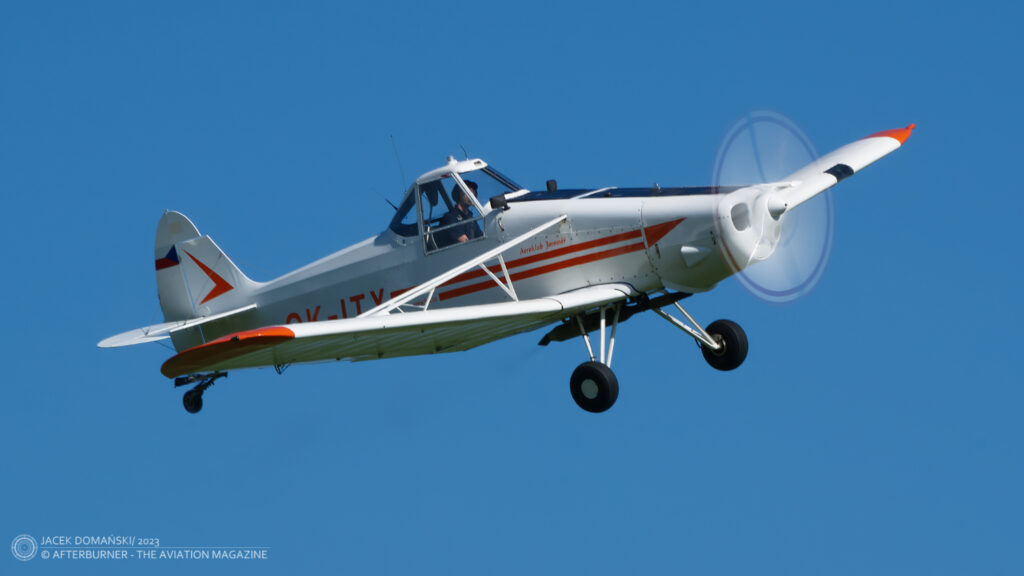 Piper PA-25 Pawnee (c/n 25-2657, OK-ITY, formerly G-ASOV / SE-ITY), performing a flypast during Aeroklub Jaroměř open day, Jaroměř, June 2023.
Piper PA-25 Pawnee (c/n 25-2657, OK-ITY, formerly G-ASOV / SE-ITY), performing a flypast during Aeroklub Jaroměř open day, Jaroměř, June 2023.
In the late 1940s, an American aviation engineer and aeroplane designer Fred Ernest Weick began his work on an experimental agricultural aircraft.
The aeroplane was developed at Agricultural and Mechanical College of Texas and was the first aircraft purposedly designed for agricultural works, such as spraying, crop dusting and fertilizer spreading. Until then, the aforementioned tasks were usually performed by civilian and military utility aeroplanes, better or worse converted for that specific duty.
However, performance of such aircraft, just quickly adapted for agricultural needs, was usually seriously deficient and faced several difficulties. Therefore, in the mid-1940s, the US-based National Flying Farmers Association launched a special research programme aimed at creation of purposedly-tailored agricultural aviation. The idea was strongly supported by the federal authorities, including the Civil Aeronautics Administration.
Consequently, the development of new agricultural aeroplanes was assigned to the Personal Aircraft Research Centre of the Agricultural and Mechanical College of Texas (AMC). There, the works were led by Fred Weick, who joined the AMC in 1948.
The first outcome of the research project was a prototype of experimental agricultural aircraft, designated Ag-1. The aeroplane was a single-seat, all-metal, cantilever low wing monoplane, powered by single Continental E225 engine. Although the Ag-1 was equipped with an open cockpit, the aircraft included several security features, aimed to reduce the risks, typical for aerial crop dusting. The cockpit was protected by two strong, curved frames to direct any cables or wires above the pilot´s head. In the lower part of the aircraft, similar hazards had to be eliminated by sharpened leading edges of the undercarriage legs.
The Ag-1 was just the first step in a long way to create an effective agricultural aircraft. It was followed by two more prototypes, designated Ag-2 and Ag-3. The latter was developed in cooperation with the Piper Aircraft company that was one of the sponsors of the AMC research programme.
The Ag-3 was based on two existing Piper aircraft, PA-18A and PA-22, sharing many of their components. The aeroplane was a single-seat, low-wing monoplane with conventional landing gear and wings construction strengthened by two struts bracing them to the fuselage. The cockpit was placed high for better visibility and moved back to allow a 360 kg (800 lb) capacity hopper to be placed in front of it.
In November of 1954, the Ag-3 successfully performed its first flight. The aeroplane was warmly welcomed by Piper, especially that further evaluation proved the Ag-3 met the assumptions. As a consequence, in 1957, Weick was invited to continue his development directly at the Piper company and the aircraft designation was officially changed to PA-25 Pawnee.
Serial production of the PA-25 was launched in 1959. However, the first years of its manufacturing were marked by searching for the best suitable engine. The Ag-3 prototype had a powerplant of only 135 hp and with the PA-25 it was quickly replaced by Lycoming O-320, generating 150 hp. Nevertheless, it still seemed the aeroplane was underpowered. Thus, in 1962 the PA-25 was equipped with a 235 hp Lycoming O-540 and next, in 1967, with high compression variant of that engine, generating 260 hp.
The PA-25 was a great commercial success. More than 5,000 examples of the aeroplane were made by Piper until 1981, when its production was ceased. However, in 1988, the complete technical documentation, engineering data and rights to produce the aircraft were acquired by Latino Americana de Aviación S.A. (now Laviasa) from Argentina.
That South American aviation company continues production of the PA-25 until today. The Laviasa-made aeroplane were renamed Puelche (meaning an indigenous people living east of the Andes Mountains in Chile and Southwest Argentina) and the company developed a few new variants of the aircraft, including a two-seater.
The Weick´s pioneer design set the long-lasting and worldwide standard for agricultural aircraft. Its basic configuration – conventional landing gear, low-wing monoplane, high placed cockpit with hopper in front section of the fuselage – was implemented with many crop dusting aeroplanes that followed the PA-25, such as AT-802 Air Tractor, PZL-106 Kruk, M-18 Dromader, Ayres Thrush, Aero Boero 260AG and Cessna 188.
The PA-25 Pawnee featured within our Photo of the Week series was manufactured in 1964 as PA-25-235. The aeroplane was purchased by ADS (Aerial) Ltd. company from the Great Britain and registered G-ASOV. With that company, the PA-25 performed a broad range of agricultural tasks by the mid-1980s.
In 1985, the aircraft was acquired by the Swedish Aero Club, registered SE-ITY, and then used as a glider tug. The PA-25 stayed in Sweden until 2020, operated as a tow aircraft by different glider associations.
At the end of 2020, the aircraft was acquired by Aeroklub Jaroměř in the Czech Republic. In the next year, the PA-25 received its Czech registration OK-ITY and, since then, serves as the glider tug at Jaroměř airfield, in the East Bohemia region.



